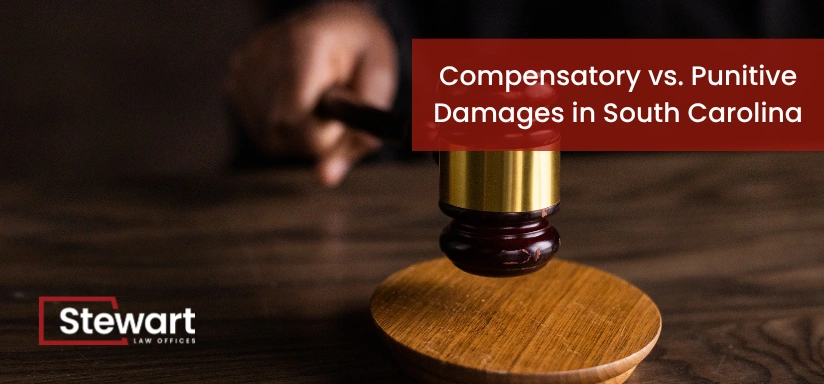If you’ve been injured in an accident caused by someone else’s negligence, the law allows you to seek financial compensation. But not all damages are the same. Some are meant to cover your actual losses, while others are designed to punish the wrongdoer.
Understanding the difference between compensatory and punitive damages can help you know what to expect in a personal injury case and why legal guidance is so important.
What Are Compensatory Damages?
Compensatory damages are intended to make the injured person “whole” again by covering actual losses. In South Carolina, they are divided into two categories:
Economic (special) damages
Measurable financial losses, such as:
- Medical bills and rehabilitation costs
- Prescription medications and medical equipment
- Lost income and diminished earning capacity
- Property damage (such as vehicle repairs or replacement)
Non-economic (general) damages
Intangible losses that don’t come with receipts, including:
- Pain and suffering
- Emotional distress and anxiety
- Loss of enjoyment of life
- Permanent disability or disfigurement
South Carolina does not impose statutory caps on compensatory damages in most personal injury cases. The exceptions are medical malpractice, where non-economic damages, including pain and suffering, are capped by law, and claims against government entities, where total recovery is subject to set maximum payout limits.
What Are Punitive Damages?
Unlike compensatory damages, punitive damages are not about repayment. They are designed to punish the defendant for egregious behavior and discourage similar conduct in the future. Punitive damages are rare and are typically awarded only when the at-fault party acted with recklessness, willful misconduct, or gross negligence.
When Are Punitive Damages Awarded in South Carolina?
South Carolina courts don’t grant punitive damages in every case. According to South Carolina Code of Laws § 15-32-520, a plaintiff must prove by clear and convincing evidence that the defendant’s conduct was reckless, willful, or malicious.
Examples might include:
- A drunk driver caused a serious crash.
- A company knowingly sells a dangerous product.
- A motorist engaging in road rage that results in injuries.
These cases transcend ordinary negligence and aim to convey a message that certain behavior will not be tolerated.
Key Differences Between Compensatory and Punitive Damages
Here’s a quick breakdown of how these two types of damages differ:
| Feature | Compensatory Damages | Punitive Damages |
|---|---|---|
| Purpose | Reimburse the victim | Punish the defendant and deter future misconduct |
| Types | Economic and non-economic | Only awarded for egregious conduct |
| Availability | Common in most personal injury cases | Rare and requires clear evidence of recklessness |
| Legal Cap | Generally uncapped (except in malpractice) | Capped at 3x compensatory or $500,000 (with exceptions) |
| Burden of Proof | Preponderance of the evidence | Clear and convincing evidence |
Understanding these differences is crucial when evaluating the potential value of your personal injury claim.
How Are Punitive Damages Calculated in South Carolina?
Punitive damages are not limitless. South Carolina caps them under South Carolina Code of Laws § 15-32-530. The maximum award is the greater of three times the amount of compensatory damages or $500,000.
However, there are exceptions:
- If the defendant’s actions were motivated by financial gain and were knowingly dangerous or the defendant’s actions could subject the defendant to conviction of a felony, the cap may rise to four times compensatory damages or $2 million.
- No cap applies if the defendant was convicted of a felony related to the injury or intended to cause harm, the defendant had an intent to harm and determines that the defendant’s conduct did in fact harm the claimant, or defendant acted or failed to act while under the influence of alcohol, drugs, or consumed other products to the degree that the defendant’s judgment is substantially impaired..
These rules ensure punitive damages remain fair while still serving as a strong deterrent.
South Carolina Laws on Damages and Statute of Limitations
South Carolina law provides a framework for both compensatory and punitive damages, but timing is everything. The statute of limitations for personal injury claims is generally three years from the date of the injury. If you miss this deadline, you may lose your right to pursue compensation entirely.
Additionally, South Carolina follows a modified comparative negligence rule. If you’re found to be more than 50% at fault, you cannot recover damages. If you’re 50% or less at fault, your compensation will be reduced proportionally.
These legal nuances make it essential to act quickly and strategically after an injury.
Why Legal Representation Matters
Successfully pursuing damages takes more than just legal knowledge; it demands a compelling case supported by strong evidence. A skilled South Carolina personal injury attorney can document both financial and emotional losses, gather expert testimony to support future damage claims, determine if punitive damages apply, and ensure compliance with legal caps, exemptions, and deadlines. They also know how to present your case effectively during negotiations or a trial.
With insurance companies working hard to minimize payouts, having a lawyer by your side helps level the playing field.
